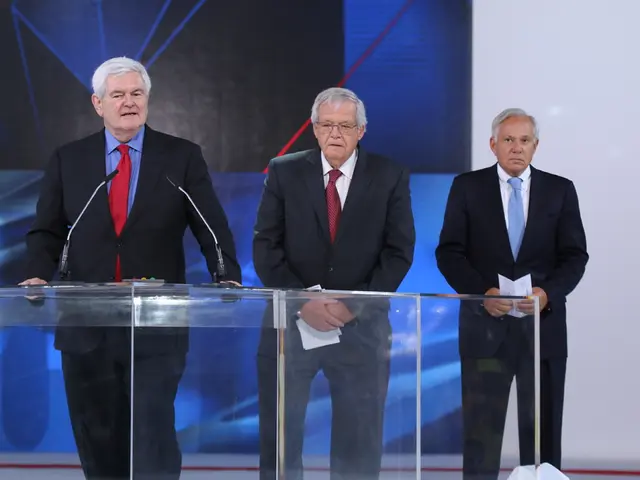Heavy rain causes flash floods in Hyderabad, resulting in severe waterlogging and disruptions to city life during a heavy downpour.
The city of Hyderabad, India, was hit by a heavy rain flash flood on August 7, 2025. The floods caused widespread waterlogging, traffic chaos, and disrupted public transport services, leaving numerous commuters stranded for hours.
Chief Minister Revanth Reddy took charge of the emergency operations, coordinating with the Telangana State Disaster Management Authority and the Greater Hyderabad Municipal Corporation (GHMC) teams to activate relief measures. However, the floods exposed existing gaps in the city's urban drainage infrastructure, with emergency communication facing hurdles and inconsistent information flow causing confusion among residents.
Studies from the Telangana State Development Planning Society reveal a 25 percent rise in urban flooding incidents in Hyderabad over the past five years, correlating with unchecked development contributing to the flash floods. Unplanned urban sprawl and construction over natural water bodies and wetlands reduce the city's natural drainage capacity, exacerbating the flood situation.
In response, the city is turning to long-term flood mitigation strategies and urban drainage improvement plans. These plans address both structural and environmental aspects to prevent and manage flash floods caused by heavy rains.
The key elements of these strategies include river Musi rejuvenation, comprehensive stormwater drainage network development, infrastructure upgrades to handle intense rainfall, obstruction removal and encroachment clearance, use of existing water bodies for temporary storage, installation of catch-pits, desilting, and road repairs, among others.
Chief Minister A Revanth Reddy has emphasized that restoring the 55-km stretch of the Musi River is the central and most viable solution for effective flood control in Hyderabad. The plan involves linking all tanks, nalas (streams), and sewage treatment plants (STPs) to the river, improving its capacity to manage stormwater and prevent flooding in low-lying areas.
The GHMC is also undertaking projects to develop a detailed, GIS-based survey and mapping of stormwater drains, especially in flood-prone zones like Ameerpet. This includes upgrading existing drains, removing blockages, and ensuring proper channeling of runoff to prevent inundation during heavy rainfall.
Recognizing that intense rainfall events (up to 20 cm in a day) are becoming more frequent due to climate change, Hyderabad officials are upgrading drainage systems and roads to handle higher rainfall volumes, far beyond the current capacity which only manages around 5 cm effectively.
The government is targeting encroachments, garbage, and plastic waste that clog drains and water bodies, including unauthorized conversion of water bodies into parking areas, which exacerbate flooding issues. These will be cleared to restore natural drainage and water flow.
Proposals include diverting stormwater to ponds such as the Krishna Kanth Park pond, which could be expanded to temporarily hold large volumes of water (up to 120 million litres), thus reducing immediate flooding impact during heavy rains.
Routine maintenance activities like desilting drains, installing catch-pits to capture debris, and repairing roads are part of ongoing efforts to improve drainage efficiency and reduce flood risks.
Together, these initiatives form an integrated approach combining river rejuvenation, advanced drainage infrastructure, pollution control, and urban planning reforms to provide sustainable, long-term flood mitigation and urban resilience for Hyderabad and similar Indian cities.
Government initiatives to incorporate advanced weather forecasting and early warning systems will be vital in mitigating future flood risks. Strengthening urban resilience involves upgrading drainage infrastructure to handle extreme rainfall volumes and implementing nature-based solutions.
Integrating real-time flood monitoring technologies and community engagement can enhance response effectiveness. Collaborative frameworks involving government, civil society, and scientific institutions can foster innovative solutions to reduce the frequency and impact of future Hyderabad heavy rain flash floods.
The Hyderabad heavy rain flash floods of August 7, 2025, disrupted daily life and revealed infrastructure constraints due to rapid urbanization. The floods exposed systemic deficiencies in flood management, with critics arguing for more investment in flood resilience infrastructure. Emergency response teams were deployed to clear clogged drains and assist trapped residents during the floods.
Public awareness campaigns and clean-up drives can empower residents to participate in risk reduction, contributing to a safer and more resilient Hyderabad.
Read also:
- Right-wing aggressions surpass left-wing responses in attacks against Kaufhold
- Brazil's Congress enacted less stringent environmental regulations.
- Torrential rainfall is characteristic of July mountain weather.
- Puzzling Extraterrestrial Encounter: Exploring the Mystery in A. Bertram Chandler's "The Cage"








